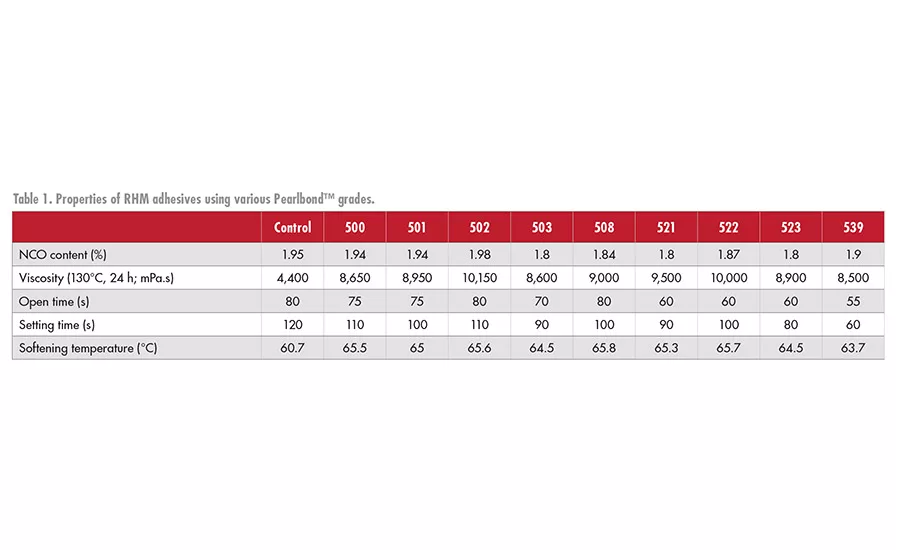Advances in Reactive Hot-Melt Technology with Thermoplastic Polyurethanes
Crystalline thermoplastic polyurethanes allow a high degree of control in formulating reactive hot-melt adhesives.



Reactive hot-melt (RHM or HMPUR) adhesives are solid prepolymers terminated in reactive groups (-NCO-) manufactured from mixtures of solid and liquid polyester/ether polyols with isocyanates, which are very low in free isocyanates. These solid prepolymers have a lower melting point than conventional hot-melt (HM) adhesives but show final strength and mechanical performance similar to a reactive system. Each of the raw materials can be appropriately adjusted to obtain required pot life, open time, and green strength.
The application temperature and viscosity of RHMs are significantly lower than standard thermoplastic HM adhesives (90-120°C), and time is needed to attain maximum bond strength. It is also important to keep in mind that the system needs protection against external moisture in the atmosphere before application.
RHMs are moisture-curing adhesives that display a fast molecular weight increase when reacted with water from ambient humidity or from free electrons in the bonded substrates. After the crosslinking reaction of the RHM, the joint shows great final strength; high flexibility, both at low and high temperatures; and great resistance to hydrolysis, heat, and chemicals.
Depending on the external environmental (humidity and temperature) and the substrates, the strength of the joint gradually increases as a function of time. The initial bond strength and physical crosslinking are activated upon cooling by the solidification of the adhesive next to the crystallization of the soft segments from the polyols. The final bond strength and chemical crosslinking is attained when the isocyanate functional groups begin to react with ambient humidity or substrates. Consequently, there is an increase in molecular weight and a fully reacted polyurethane with urethane and urea groups alternately placed in the chemical structure, resulting in a strong and durable adhesive bond.
Although synthetic adhesive technology is almost a century old, it is necessary to advance the technology with an eye on market needs and new regulatory requirements. Crystalline thermoplastic polyurethane (TPU) additives* have become a standard in RHM formulations over the past decade, offering economical and excellent RHM performance. When an RHM is formulated, the choice of the components is important and governs the final properties, which is where crystalline TPUs contribute value and differentiation.
Influence of Various Additives on RHMs
Among all additives, crystalline TPUs allow for greater control on the final RHM to meet the application requirements. Grades of TPUs differ from each other in their chemical structure and variety of molecular weights. The chemical variations offer a range of products with different crystallization rates, polar groups (urethane groups), and molecular weights.
Tests were performed to understand the behavior of various crystalline TPU grades and their effects on RHM properties. To determine chemical structure dependence, a test was initiated with a highly crystalline polyester (1, 6 hexane-diol adipate), to which 5% of each of several crystalline TPU grades were added. These mixtures were melted and homogenized with stirring at 135°C for 2 hrs under a nitrogen atmosphere to eliminate moisture. They were then reacted for 1 hr with diphenyl methane 4, 4- diisocyanate (MDI) at a molar ratio of NCO/OH =1.95:1.
The end product was packaged in several small containers, sealed with a nitrogen blanket, and allowed to fully react for 24 hrs. After the reaction, the main properties were determined, and the obtained values are shown in Table 1. The addition of TPU grades with a high crystallization rate slightly decreased the open and setting times (see Figure 1). The reduction varies depending on the molecular weight of the crystalline TPU.
As shown in Figure 2, when the crystallization rate of the TPU additive is very high, the open and setting times show a greater decrease in comparison with the control (no crystalline TPU added). In addition, it was determined that crystalline TPU grades with lower molecular weight (or higher MFI) provide greater decreases in open and setting times.
The effects of crystallization rate and polarity of crystalline TPUs were tested with respect to the initial and final adhesion values. The comparison of crystallization rate was determined between two grades of crystalline TPU that have low polarity but varying crystallization rates. In this test, the previously synthesized RHMs were used, and the effects of the two crystalline TPU grades were compared with a third grade that shows a lower crystallization rate due to an increase in the polarity of the polymer. Crystallization rate results are shown in Figure 3.
Additional Capabilities
Different grades of crystalline TPUs can provide additional capabilities. For example, one TPU is renewably sourced and features a very high speed of crystallization.** This crystallization presents several benefits vs. crystalline TPU from petrochemical-based materials, including cost savings in formulation, decreased setting and open times, and increased green strength and melt viscosity. Figure 4 details the crystallization rate of the renewably-sourced TPU compared to polycaprolactone polyol.
With high wettability and polarity, another grade of crystalline TPU is a linear, polycaprolactone-copolyester polyurethane with a low crystallization rate and a medium thermoplasticity level.† It can be added to formulations of RHM to regulate the crystallization speed and increase the wettability/tackiness and final adhesion to different substrates due to its high polarity.
Multiple Benefits
The addition of a crystalline TPU during the synthesis process of an RHM adhesive formulated with defined polyester components (crystalline and amorphous) provides the following:
- Setting and open time regulation—related to crystallization rate, molecular weight, and polarity
- Higher green strength—faster working cycle
- Final bond strength improvement—related to polarity in the crystalline TPU
- Higher specific adhesion strength—related to polarity of the crystalline TPU
- Higher melt viscosity—related to molecular weight and concentration of the crystalline TPU
For more information, visit www.lubrizol.com/engineeredpolymers.
*such as Pearlbond™ from Lubrizol Advanced Materials, Inc.
**Pearlbond™ ECO 590
†Pearlbond™ 893
Looking for a reprint of this article?
From high-res PDFs to custom plaques, order your copy today!







